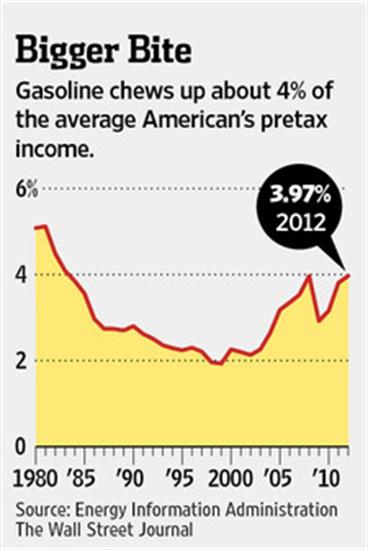Blog
Wall Street Journal: Gasoline Costs Hit Families' Finances"The average U.S. household paid an estimated $2,912 for gasoline last year, sucking up nearly 4% of the average household income before taxes, according to government data out Monday. That is the highest percentage in three decades, with the exception of 2008, when the rate was nearly identical."
WASHINGTON, D.C.,
February 12, 2013
|
@NealKirby
Gasoline Costs Hit Families' Finances Gasoline prices took a big bite out of Americans' pocketbooks in 2012. The average U.S. household paid an estimated $2,912 for gasoline last year, sucking up nearly 4% of the average household income before taxes, according to government data out Monday. That is the highest percentage in three decades, with the exception of 2008, when the rate was nearly identical.
Many people are trying to cut down on fuel costs as they crunch the numbers on other family expenses. At an Exxon station just a few blocks from the U.S. Capitol, where a gallon of regular gas cost $4.49, car owners said they often waited to fill up their tank at cheaper stations and had started to calculate the shortest routes to conserve fuel. Anne McKenna, a lawyer based in Baltimore, said she and her husband were saving for college for their three children. With a weekly gasoline bill that can reach $150, they take turns using the family's most fuel-efficient car, depending on who has a longer drive to make on any given day. "It's just the kind of thing you're aware of," Ms. McKenna said. The nation's average price of gasoline is $3.52 a gallon, up 17 cents from a week ago, according to the AAA Fuel Gauge. The single largest determining factor in the price of gasoline is the price of crude oil, which recently traded at about $96 a barrel. The flip side of higher prices: The U.S. is using slightly less gasoline, thanks to thrifty drivers and more fuel-efficient cars. As of November, the U.S. was using about 8.7 million barrels of gasoline a day, down from nine million barrels a day in 2010, according to the Energy Information Administration. |
Newsletter Sign Up
Sign up to receive news, updates and insights directly to your inbox.


